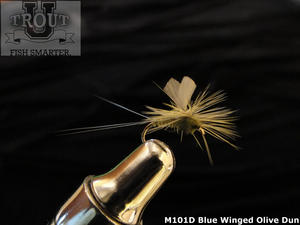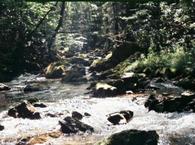
As previously explained in the Trout University Class 206 “What Can Trout See” a trout’s view of the world is through what is called the "trout's window". This window is a cone shaped like an upside down ice cream cone. The diameter of cone of vision increases in proportion to the distance from the eye; in other words, the deeper the trout, the greater the cone of vision. Conversely, the shallower the trout is, the smaller the cone of vision. Note that this cone allows the trout to see in 330 degrees of the circle which is everything except the 30 degrees directly behind him. A trout will only eat something that he can inspect and therefore it must be within his cone of vision before he will eat it.
This leads us to the first and the most important lesson in fly fishing for trout; when casting a fly to a rising trout, you must land the fly upstream of where you saw the rise and not where the rise occurred. If the fly is presented upstream from the rise, it will float downstream and naturally appear within the trout’s cone of vision. Although trout have relatively small brains, they have learned instinctively not to take anything suspicious. Those that do not learn that lesson are “culled” out of the stream at an early age.
Should a fly land outside the window of vision, a trout can only see the portion of the fly that extends below the surface film which may be part of the hook, the six legs of the insect, or the hackle of the fly. Depending on how high the fly is riding in the water, he may see part of the body of the fly. Anything above the surface can not be seen by the trout if it remains outside the circle of vision.
If your fly is very dry or has floatant applied adequately, the trout would see much less of the fly than it would if the fly was saturated or had no application of floatant. Conversely, if the entire body of the fly settled below the surface, the fly would see the entire fly.
Now, we are getting to my point. A natural insect like the blue winged olive mayfly is extremely light in weight. It has to be much lighter than any fly tied with a hook in it, so obviously, a trout will see less of the natural fly than he would see of the imitation fly with the hook. No fly can be tied lighter than the live blue winged olive!
So it stands to reason that the application of floatant is going to cause the fly to be a better imitiation of the natural insect. Not only will it ride higher and be more realistic, but it will float longer. This natural presentation will cause the trout to expend the energy necessary to position himself such that the fly will be within his cone of vision available for closer inspection and finally taking the fly. When the fly does not ride high in the water the trout becomes suspicious and will not move.
The application of floatant is very beneficial when the fly has dried his wings and is about to depart the water. Of course, there are times when it is best to throw a wet fly like an emerger.
Remember, if your “dry” dry fly lands in the feeding lane, it will float properly into the trout’s cone of vision; and should you miss the feeding lane, a “dry” dry fly will entice the trout to move allowing him to better inspect and take the fly.





